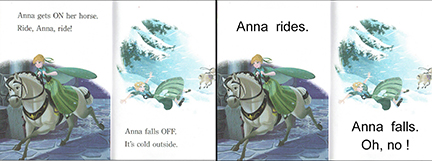MODIFYING BOOKS FOR READING SUCCESS: YOU CAN DO THIS!
Last weekend I had the fun of giving reading workshops for The 21 Club in New Hartford, NY, and as usual I ended the day with a hands-on workshop for modifying trade books. I can’t overstate the importance and the impact these books have on our kids! We make it possible for them, even in the early stages of emergent reading, to successfully read “REAL” books on topics they love. I still have a Winnie-the-Pooh book I modified for my son Jonathan (DS, 30) when he was five. He loved it, of course. This is something you will want to do…you only need to know the basic guidelines.
I often talk about my teaching M.O., which is “Go in through the heart and teach to the brain.” Well, this is the Heart Part, and your child will love it. The Brain Part is in the “how to.”
For Home or Classroom
The rules of modification are the same whether you’re adapting school reading material or trade books, so this blog applies equally to both areas. In most cases, modifying school materials will be a necessity; modifying trade books is optional, but these are gems and will rock the socks off your reader, regardless of age. Because I’m a reading tutor for children/teens/adults with DS, I have amassed a terrific collection of modified trade books which I keep under lock and key! They’re like gold, and I don’t want them to sprout legs and walk off.
Each of these awesome books is coupled with homemade flash cards I’ve made; you’ll want to teach the most important words in the book with the Fast Flash method. (If you want to see what that looks like, here’s a video of Fast Flash.)
Lead the Way
With the dramatic increase (we hope) in inclusion settings, modification of materials becomes a hot topic. Some schools handle it well and some…don’t. So what can you do to help? You can become an expert in modifying reading materials, for a start. The art and knowledge of modification is in its infancy; most schools are not used to providing it, and many don’t have a clue how to meet the visual and cognitive needs of the student, even though they sincerely want to. So we can point the way…
HOW TO
The rules are few but essential. And as I mentioned, the guidelines are the same whether the book is school reading material or a trade book.
TEXT
- What’s an appropriate reading level? The level of text the student is required to read should be a slight stretch but not more than that; a good rule of thumb is that the student should know solidly AT LEAST 80% of the words in the text; that’s a ratio of 4:1. I say again, at least. I spoke with Sue Buckley (of Downs Ed International) about this, and she told me that depending on the student, the ratio may need to be 90%-95% known vocabulary. Whoa! How far from that goal is the material your child is now working with? We want the reading material we put in front of the child to get across the message, You can do this!
- Determine the level: Download the Dolch high-frequency word list for free from www.mrsperkins.com and find the list that most closely matches your child’s current reading level. Use words from that list that are still not yet mastered; for example, maybe the “Primer List” of 52 words is mostly familiar to your child but there are definite “holes” in that list which are not solid. See if you can work those words into the rewrite of the book, which you’re going to create.
- Look only at the picture in the book when you’re trying to create new text! That’s what your child will see. It doesn’t actually matter what the original text was; what does the picture say to the child? That’s all you need to be concerned with. You’re going to be covering the original text with new text on a permanent label, so the exact original doesn’t matter. What matters is that it makes sense to the child and that it’s at a successful reading level.
- Rewrite the text on a sticky note and put it on the page temporarily until you’re ready to type it on real labels. If you work with sticky notes, you can change your mind as needed. When you’ve got the text like you want it, make it permanent with labels like this:
- Type the new text on FULL LABEL SHEETS which you can buy at any office supply store. Full label sheets are best because you want as much width on the page as possible so your type can be LARGE. Cut the label to cover the original text so it doesn’t show at all. (Do not, repeat, do not handwrite in these modified books! Unless you’re a professional calligrapher, your little reader will struggle to recognize your differing letter shapes and sizes.)
- Is the sentence length and complexity on target? An emergent reader needs a sentence maximum of 3-4 words. With each step of advancement, you can increase sentence length. But don’t jump too soon…a child needs to be able to handle the sentence length in the reading materials, for several reasons. One, the longer the sentence, the more challenging (and potentially discouraging) the reading task. Two, the longer the sentence, the longer it takes for the student to work her way through it; for comprehension purposes, that’s a boat-sinker. By the time she reaches the end of the sentence, she doesn’t remember the beginning. Does this sound familiar? So make sure the sentence length is manageable.
- Create flash cards for the most important unknown vocabulary (or all, if you like) in the book. Teach the Fast Flash method, and use my Sandwich Teaching Method: A-B-A: fast flash the cards–read the book–fast flash the cards. All done! Nothing but fun when you’re doing this. Testing is for another time.

LAYOUT
- Font choice: use a “sans serif” font like Arial, Verdana, Tahoma, or Helvetica. Sans Serif means there are no “Serifs” or fancy (and distracting) endings on letter strokes. We want a font without (sans) that so the type is as clear as it can be. Just about anything you read on the internet is posted in a sans serif font. Take a quick look at Amazon or any site. Hmmmmm…never noticed that before? Why do websites use this kind of font? Because brains can read it most easily, and sites want you to buy their stuff. Simple.
- Font Size: SIZE MATTERS. This is so important in the beginning, until the student has fair fluency going. Keep the font size large, at least 24 pt. and preferably 32 pt. and larger. The younger the student, the less mature the visual pathway, and we’ll see the fastest progress if we match font size with age and reading experience. So the younger the child, the larger the font, for use in both flash cards and books.
- Font Style: Use regular, not bold; though it may seem counter-intuitive, using a boldface font makes text harder to read.
- Word Spacing: This is a rule you can’t break for a long time: double space between each word. Most fonts of themselves do not provide enough spacing (“kerning”) between words for our purposes, so you have to add an extra space. What does this do for the brain? It makes the job of word recognition and retention so much easier. We eliminate the brain’s struggle with “Where does the first word end, and the second one begin?”
- Line Spacing: It’s helpful to add extra leading [“ledding”] or spacing between lines; white space of any kind aids clarity, focus, and retention.
Working Around The Built-In School Handicap
What handicap? The school’s handicap is that the materials they are required to work with are frequently–how can I say this?–boring. Teachers can work around this a bit by including Personal Books in their curriculum mix. (See my blog on Personal Books for details of how-to.) They can also include the totally awesome element of modified trade books in the classroom. Imagine a first grader’s reaction to successfully reading a “Minions” book in the classroom. But boring or not, the curriculum used in the classroom is typically what you’ll be dealing with unless you have a teacher open to using materials designed especially for our kids.
So what can you do? Suggest the same modifications I’ve listed above which we follow for trade books. Text of school materials needs to be rewritten at the appropriate level of difficulty, or at the very least photocopied enlarged, the text broken up more frequently with engaging visuals and plenty of “white space” provided on a visual field. White space gives the brain a break and helps it understand where to focus. These modifications will make a world of difference, and can easily be the difference between “It’s too hard!” and “I did it!”
Where to buy these trade books?
My favorite brand, the publisher who sticks most closely to the reading level boasted on the upper right corner of the cover, is Random House’s “Step Into Reading” series. You can find these at Target, Walmart, Kmart, etc. If you’re lucky, you can find other publishers’ books as well, but be warned…there is NO quality control in place in the trade book industry for reading standards! They can put whatever level they jolly well please on the cover! “Level One” on the cover can be fourth grade level inside, so be a skeptic and check each book for honesty.
Off to StuffMart now to get more cool books to modify…have fun with this!




Thank you, Natalie! This is so valuable!
You’re welcome!
Any thoughts / guidance/ resources for reading with a nonverbal child? Step One Reading Books “seem” ok for him – but very difficult to tell due to his lack of ability to chat or make meaningful comments. Wondering if I should be adapting more.
Have you read the several articles on my site on that topic? Specifically for teaching learners who are nonverbal? Use the search box on my main blog page and type in “non verbal” and also “non-verbal”. That will help the search feature to pull up the articles you need. I have used those articles to give you the info you’re seeking. Good luck!